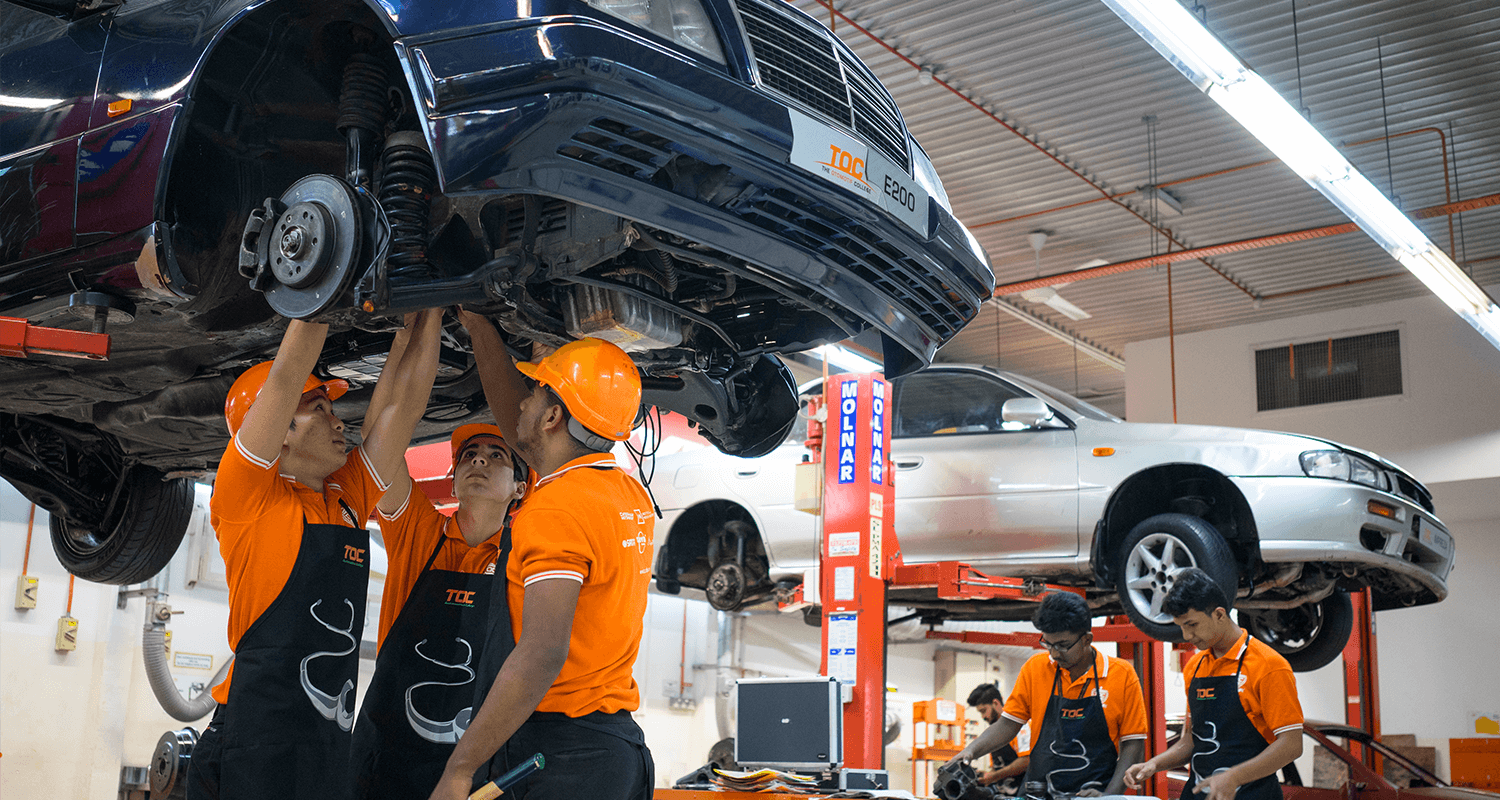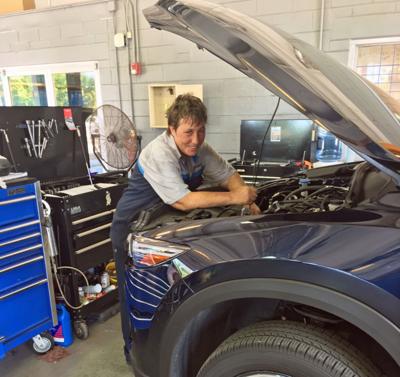Free Service Technician Level 3 Course (6Months)
Service Technician Level 3:
Brief Job Description
An Auto Service Technician Level 3 assists in service, maintenance and technical repair of vehicles
Personal Attributes
An individual on this job must have good communication and interpersonal skills in addition to being a team player, as the job requires coordination with other technicians. An individual on this job should also have good memory to recall the various workshop tools, equipment, gauges and fixtures and their storage location for easy retrieval when asked by the senior technicians. The individual must also have a technical bend of mind to have basic knowledge of vehicles and understanding of the technical aspects of various components/ aggregates in a vehicle.
Plan and organise work to meet expected outcomes:
Elements and Performance Criteria
Work requirements including various activities within the given time and set quality standards
To be competent, the user/individual on the job must be able to:
PC1. keep immediate work area clean and tidy
PC2. treat confidential information as per the organisations guidelines
PC3. work in line with organisations policies and procedures
PC4. work within the limits of job role
PC5. obtain guidance from appropriate people, where necessary
PC6. ensure work meets the agreed requirements
Appropriate use of resources
To be competent, the user/individual on the job must be able to:
PC7. establish and agree on work requirements with appropriate people
PC8. manage time, materials and cost effectively
PC9. use resources in a responsible manner
Knowledge and Understanding (KU)
The individual on the job needs to know and understand:
KU1. the organisations policies, procedures and priorities for area of work, role and responsibilities in carrying out that work
KU2. the limits of responsibilities and when to involve others
KU3. specific work requirements and who these must be agreed with
KU4. the importance of having a tidy work area and how to do this
KU5. how to prioritize workload according to urgency and importance and the benefits of this
KU6. the organisations policies and procedures for dealing with confidential information and the importance of complying with these
KU7. the purpose of keeping others updated with the progress of work
KU8. who to obtain guidance from and the typical circumstances when this may be required
KU9. the purpose and value of being flexible and adapting work plans
KU10. how to complete tasks accurately by following standard procedures
KU11. technical resources needed for work and how to obtain and use these
Generic Skills (GS)
User/individual on the job needs to know how to:
GS1. write in at least one language
GS2. read instructions, guidelines/procedures
GS3. ask for clarification and advice from appropriate persons
GS4. communicate orally with colleagues
GS5. make a decision on a suitable course of action appropriate for accurately completing the task within resources
GS6. agree objectives and work requirements
GS7. plan and organise work to achieve targets and deadlines
GS8. deliver consistent and reliable service to customers
GS9. check own work and ensure it meets customer requirements
GS10. anomalies to the concerned persons
GS11. analyse problems and identify work-arounds taking help from
GS12. apply own judgement to identify solutions in different situations

Work effectively in a team:
Elements and Performance Criteria
Effective communication
To be competent, the user/individual on the job must be able to:
PC1. maintain clear communication with colleagues
PC2. work with colleagues
PC3. pass on information to colleagues in line with organisational requirements
PC4.. work in ways that show respect for colleagues
PC5. carry out commitments made to colleagues
PC6. let colleagues know in good time if cannot carry out commitments, explaining the reasons
PC7. identify problems in working with colleagues and take the initiative to solve these problems
PC8. follow the organisations policies and procedures for working with colleagues
PC9. ability to share resources with other members as per priority of tasks
Knowledge and Understanding (KU)
The individual on the job needs to know and understand:
KU1. the organisations policies and procedures for working withcolleagues, role and responsibilities in relation to this
KU2. the importance of effective communication and establishing goodworking relationships with colleagues
KU3. different methods of communication and the circumstances inwhich it is appropriate to use these
KU4. benefits of developing productive working relationships withcolleagues
KU5. the importance of creating an environment of trust and mutualrespect
KU6. whether not meeting commitments, will have implications onindividuals and the organisation
KU7. different types of information that colleagues might need and theimportance of providing this information when it is required
KU8. the importance of problems, from colleagues perspective andhow to provide support, where necessary, to resolve these
Generic Skills (GS)
User/individual on the job needs to know how to:
GS1. complete well written work with attention to detail
GS2. read instructions, guidelines/procedures
GS3. listen effectively and orally communicate information
GS4. make decisions on a suitable course of action or response
GS5. plan and organise work to achieve targets and deadlines
GS6. check that the work meets customer requirements
GS7. deliver consistent and reliable service to customers
GS8. apply problem solving approaches in different situations
GS9. apply balanced judgements to different situations
GS10. apply good attention to detail
GS11. check that the work is complete and free from errors
GS12. get work checked by peers
GS13. work effectively in a team environment

Maintain a healthy,safe and secure working environment:
Elements and Performance Criteria
Resources needed to maintain a safe, secure working environment
To be competent, the user/individual on the job must be able to:
PC1. comply with organisations current health,safety and security policies and procedures
PC2. report any identified breaches in health,safety, and security policies and procedures to the designated person
PC3.. Coordinate with other resources at the workplace to achieve the healthy, safe and secure environment for all incorporating all government norms esp. for emergency situations like fires,earthquakes etc.
PC4. identify and correct any hazards like illness, accidents, fires or any other natural calamity safely and within the limits of individuals authority
PC5. report any hazards outside the individuals authority to the relevant person in line with organisational procedures and warn other people who may be affected
PC6. follow organisations emergency procedures for accidents, fires or any other natural calamity
PC7. identify and recommend opportunities for improving health,safety, and security to the designated person
PC8. complete all health and safety records are updates and procedures well defined
Knowledge and Understanding (KU)
The individual on the job needs to know and understand:
KU1. legislative requirements and organisations procedures for health, safety and security and individuals role and responsibilities in relation to this
KU2. what is meant by a hazard, including the different types of health and safety hazards that can be found in the workplace
KU3. how and when to report hazards
KU4. the limits of responsibility for dealing with hazards
KU5. the organisations emergency procedures for different emergency situations and the importance of following these
KU6. the importance of maintaining high standards of health, safety and security
KU7. implications that any non-compliance with health, safety and security may have on individuals and the organisation
KU8. different types of breaches in health, safety and security and how and when to report these
KU9. evacuation procedures for workers and visitors
KU10. how to summon medical assistance and the emergency services,where necessary
KU11. how to use the health, safety and accident reporting procedures and the importance of these
Generic Skills (GS)
User/individual on the job needs to know how to:
GS1. complete accurate, well written work with attention to detail
GS2. read instructions, guidelines/procedures/rules
GS3. listen and orally communicate information
GS4. make decisions on a suitable course of action or response
GS5. plan and organise work to achieve targets and deadlines
GS6. build and maintain positive and effective relationships withcolleagues and customers
GS7. apply problem solving approaches in different situations
GS8. analyse data and activities
GS9. apply balanced judgements to different situations
GS10. apply good attention to detail
GS11. check that the work is complete and free from errors
GS12. get work checked by peers
GS13. work effectively in a team environment

Assist in service, maintenance and repair of the vehicle.:
Elements and Performance Criteria
Assist in service, maintaiance and actual repair of the vehicle
To be competent, the user/individual on the job must be able to:
PC1. . collect and safely handover personal belongings of customer like phone, pen, documents etc, at the time of taking a vehicle for servicing or repairs
PC2. . place the vehicle on a suitable platform, before the painting actually starts
PC3. . assist in organising the secure parking area and moving vehicles around as directed
PC4. . lift raw materials, finished products, and packed items, manually or using hoists
PC5. . understand the autocomponent manufacturer specifications related to the various
components/ aggregates in the vehicle
PC6. . ensure that service, maintenance and repair activities are carried out on the vehicle without causing damage to any other other aggregate/ component
PC7. . run errands at the direction of the senior technician such as gettingfetching parts,tools, gauges, instruments, fixtures, workshop supplies, taking vehicles to dealerships etc.
PC8. . assist in performing service or repair of vehicles under supervision of senior technician such as: carrying out minor component repair or replacement carrying out oil changes and lubrication washing vehicles as per prescribed standard process fetching correct materials or tools or gauges mixing cleaning solutions, abrasive compositions, or other compounds, as per the directions given by senior technician
PC9. . dismantle aggregates like wheels,suspension system, steering column,braking system,engine assembly etc.
PC10.. count and report serviced or repaired vehicles to determine if product orders are complete
PC11. . assist in maintaining and managing the workshop, tools, equipment and machinery in required condition by: cleaning and lubricating equipment rinsing objects, tools and equipment and placing them on drying racks using cloth, squeegees or air compressors to dry surfaces cleaning and organising the workshop placing tools at their shelf after use keeping workshop clean of debris
PC12. . follow standard operating procedures specially vehicle service manuals for using workshop tools and equipments
PC13. . ensure any malfunctions or repair requirements observed in vehicles (and beyond own scope of work) are reported to the concerned person
PC14. . ensure any malfunctions observed in tools and equipments are reported to the concerned persons
PC15. . assist in fitting and balancing the replaced and refitted parts
PC16.. ensure that trainings organized by the OEM from time-to-time are attended and knowledge levels are upgraded (esp. in case of newly launched products, product refreshes)
Knowledge and Understanding (KU)
The individual on the job needs to know and understand:
KU1. standard operating procedures of the organisation/ dealership for inspection, servicing and repair of vehicles to be followed
KU2. standard operating procedures recommended by the dealership/ suppliers/OEM for using tools and equipment to be followed as per the manufacturer instructions
KU3. safety requirements for equipment and components/ aggregates as prescribed by the OEM(e.g. preventing/ dealing with oil spillage and inflammable materials)
KU4. documentation requirements for each procedure carried outas part of roles and responsibilities as specified by OEM/ autocomponent manufacturer
KU5. organisational and professional code of ethics and standards of practice
KU6. safety, health and environmental policies and regulations for the workplace as well as for automotive trade in general (e.g. safe practices while working in pits/ under vehicles)
KU7. workplace policies and schedules for housekeeping activities and equipment maintenance
KU8. the basic functioning of various components and aggregates ofvehicles including: engines and fuel system (diesel, petrol, electrical, gas, hybrid etc.) cooling system air supply systems emission and exhaust system ignition systems clutch assembly clutch operating system gearbox (manual and automatic) drivelines and hubs drive-train assembly and transmission systems (manual, automatic etc.) steering system suspension system brake system (including regenerative braking systems) tyres and wheels (including wheel alignment) radiator batteries and power storage system power-generating systems (including charging systems especially for electrical and hybrid vehicles) electrical wire harness, lighting, ignition, electronic and air-conditioning systems etc. energy recuperation systems, if applicable (e.g. in electric, gas and hybrid vehicles) electronic systems including active and passive safety, media and other systems electronic control unit hydraulic and pneumatic system various lubrication systems
KU9. the storage location for the tools and materials used in the workshop
KU10. the tools used during routine servicing and repairs, including use of: pressure indicators: fuel pressure testers, manifold gauge sets, oil pressure gauges, tire pressure gauges etc. pullers: ball joint separators, bearing pullers, gear puller tools, slide hammers etc. specialty wrenches: alignment wrenches, chain wrenches, locking wrenches, lug wrenches etc. measuring equipment: veneer calipers, micrometer, feeler gauges, etc.
KU11. the type, quality and codification system of components specified by the OEM for use as replacement parts
KU12. the instructions related to grade of oils, lubricants and greases specified by the OEM for use
Generic Skills (GS)

User/individual on the job needs to know how to:
GS1. record and document the basic details of repairs and maintenance performed on various aggregates/ components
GS2. record all diagnostics done by senior technicians as per the prescribed format recommended by the OEM/ autocomponent manufacturer
GS3. write in at least one language
GS4. read the basic specification of a vehicle or any other component or part
GS5. read work orders, specifications etc. related to the job including instructions mentioned on the job card
GS6. read the service circulars/ sign boards placed in the workshop with respect to the overall process to be followed for service, repair and maintenance of the vehicle
GS7. read any specific safety related guideline (applicable for CNG/ LPG/ Electric vehicle)
GS8. interact with customer/ service advisor and senior technicians
GS9. interact with team members including colleagues in the workshop to work efficiently
GS10. judge when to seek assistance from a superior
GS11. decide on the level of top up required of various lubricants/ oil/ coolant/ grease for routine maintenance of the vehicle after judging the current levels
GS12. plan work according to the required schedule and location
GS13. organise the schedule to complete the work on the vehicle timely in case other aggregate repairs/ maintenance work is also required to be done
GS14. organise the workplace and work according to the principles of 5S
GS15. ensure that customer needs are assessed and every effort is made to provide satisfactory service
GS16. assist in repairs under the supervision of the senior technician
GS17. bring any noticeable issues (both in the aggregates currently working or any other aggregate on which there is no work to be done) to the attention of the supervisor
GS18. evaluate the complexity of the tasks to determine if he/she needs any assistance from the senior technician
GS19. analyse, evaluate and apply the information gathered from observation, experience, reasoning, or communication to act efficiently
Assessment Guidelines
- Criteria for assessment for each Qualification Pack will be created by the Sector Skill Council. Each Element/ Performance Criteria (PC) will be assigned marks proportional to its importance in NOS. SSC will also lay down proportion of marks for Theory and Skills Practical for each Element/ PC.
- The assessment for the theory part will be based on knowledge bank of questions created by the SSC.
- Assessment will be conducted for all compulsory NOS, and where applicable, on the selected elective/option NOS/set of NOS.
- Individual assessment agencies will create unique question papers for theory part for each candidate at each examination/training center (as per assessment criteria below).
- Individual assessment agencies will create unique evaluations for skill practical for every student at each examination/ training center based on these criteria.
- To pass the Qualification Pack assessment, every trainee should score the Recommended Pass % aggregate for the QP.
- In case of unsuccessful completion, the trainee may seek reassessment on the Qualification Pack.







